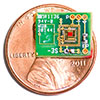The MIT Energy-Efficient Circuits and Systems Group led by Prof. Anantha Chandrakasan is involved with the design and implementation of various integrated systems ranging from ultra low-power wireless sensors and multimedia devices to high performance processors. Research spans across multiple levels of abstraction ranging from innovative new process technologies and circuit styles to architectures, algorithms, and software technologies. A key focus of this group is developing energy efficient integrated solutions for battery operated systems.
For more detailed information see the Energy-Efficient Circuits and Systems Group Website.

Security for Internet of Things (IoT)
The sheer number and diversity of IoT devices, along with their limited resources, makes IoT security a challenge quite different from securing traditional computing systems. As a circuits and systems group, we have been working on the design of low-power cryptographic hardware accelerators, wireless authentication tags and energy-efficient security protocols. Apart from the traditional approach, we are also exploring novel applications of security like speech authentication, physical layer security in RF transceivers, and authentication in the analog domain.
Research Team
Chiraag Juvekar, Utsav Banerjee, Mohamed Radwan Abdelhamid, Rabia Tugce Yazicigil, Phillip Nadeau, Skanda Koppula, Daniel Richman, Andrew Xia
Related Recent Publications
- Desai N., C. Juvekar, S. Chandak, A. P. Chandrakasan, “An Actively Detuned Wireless Power Receiver with Public Key Cryptographic Authentication and Dynamic Power Allocation,” IEEE International Solid-State Circuits Conference (ISSCC), Feb. 2017.
- Juvekar, C. S., H. M. Lee, J. Kwong, A. P. Chandrakasan, “A Keccak-based wireless authentication tag with per-query key update and power-glitch attack countermeasures,” IEEE International Solid-State Circuits Conference (ISSCC), Feb. 2016. [link]

Energy Harvesting and Wireless Charging for Internet of Things (IoT)
Most applications for IoT require that the sensors employed in such applications be self-powered and perform both sensing and transmission of information at low power levels. Researchers working in this theme are engaged in developing full system-level solutions to applications such as machine health monitoring, acoustic energy harvesting for flight noise monitoring etc. The approach followed here is to co-design both the harvesters and the associated low-power circuits. Some of the challenges and innovative circuit-level solutions in this theme are: achieving low-voltage startup, impedance matching and frequency tuning for efficient broadband power extraction, providing regulated output voltage for the RF-circuits to transmit the information etc. The theme brings together novel devices, sensors and low-power electronics.
Research Team
Ujwal Radhakrishna, Preetinder Garcha, Nathan Monroe
Related Recent Publications
- Desai N., C. Juvekar, S. Chandak, A. P. Chandrakasan, “An Actively Detuned Wireless Power Receiver with Public Key Cryptographic Authentication and Dynamic Power Allocation,” IEEE International Solid-State Circuits Conference (ISSCC), Feb. 2017.
- Desai N., A. P. Chandrakasan, “A ZVS resonant receiver with maximum efficiency tracking for device-to-device wireless charging,” IEEE European Solid-State Circuits Conference (ESSCIRC), Sep. 2016. [link]
- El-Damak, D., A. P. Chandrakasan, “Solar Energy Harvesting System with Integrated Battery Management and Startup Using Single Inductor and 3.2nW Quiescent Power,” IEEE Symposium on VLSI Circuits (VLSIC), pp. 280-281, June 2015.

Energy-Efficient Circuits and Systems for Multimedia Processing
Multimedia applications, such as video playback, computational photography and speech processing, are becoming increasingly pervasive on battery-operated portable multimedia devices such as smartphones and tablets. High computational complexity of such applications requires efficient hardware implementations for real-time energy-efficient processing. In our group, we have been working on the design of energy-efficient accelerators for computational photography and vision, video decoding, keyword and speech/speaker recognition and on application-specific SRAM design. We explore power reduction techniques at various design stages (algorithms, architectures and circuits) to enable efficient integration of such applications on mobile devices.
Research Team
Mehul Tikekar, Priyanka Raina, Avishek Biswas, Zexi Ji, Miaorong Wang, Skanda Koppula, Di-Chia Chueh, Jiarui Huang
Related Recent Publications
- Price M., J. Glass, A. P. Chandrakasan, “A Scalable Speech Recognizer with Deep-Neural-Network Acoustic Models and Voice-Activated Power Gating,” IEEE International Solid-State Circuits Conference (ISSCC), Feb. 2017.
- Raina P., M. Tikekar, A. P. Chandrakasan, “An energy-scalable accelerator for blind image deblurring,” IEEE European Solid-State Circuits Conference (ESSCIRC), Sep. 2016. [link]
- Biswas A., A. P. Chandrakasan, “A 0.36V 128Kb 6T SRAM with energy-efficient dynamic body-biasing and output data prediction in 28nm FDSOI,” IEEE European Solid-State Circuits Conference (ESSCIRC), Sep. 2016. [link]
- Jeon, D., N. Ickes, P. Raina, H. C. Wang, A. P. Chandrakasan, “24.1 A 0.6V 8mW 3D vision processor for a navigation device for the visually impaired,” IEEE International Solid-State Circuits Conference (ISSCC), Feb. 2016. [link]
- Tikekar, M., C.-T. Huang, V. Sze, A. Chandrakasan, “Energy and Area-Efficient Hardware Implementation of HEVC Inverse Transform and Dequantization,” IEEE Interational Conference on Image Processing, Oct. 2014. [link]

Platforms for Ultra-Low Power Biomedical Electronics
Our group’s approach to biomedical electronics starts with developing a deep understanding of physiological or biological processes, which leads to new insights on how to develop an energy-efficient implementation of the system. Our focus is on enabling new applications and on dramatically lowering the energy consumption for existing ones. For both, we collaborate with a number of groups on MIT campus from the brainstorming phase, through to the implementation and experimentation.
Research Team
Phillip Nadeau, Bonnie Lam, Sirma Orguc, Harneet Khurana, Andrew Mullen
Related Recent Publications
- Nadeau P., M. Mimee, S. Carim, T. K. Lu, A. P. Chandrakasan, “Nanowatt Circuit Interface to Whole-Cell Bacterial Sensors,” IEEE International Solid-State Circuits Conference (ISSCC), Feb. 2017.
- Lam B., M. Price, A. P. Chandrakasan, “An ASIC for Energy-Scalable, Low-Power Digital Ultrasound Beamforming,” IEEE International Workshop on Signal Processing Systems (SiPS), Oct. 2016. [link]